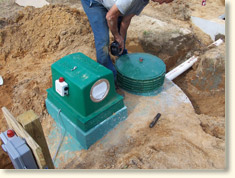Secondary Septic Systems
 In the past, where a conventional Septic System would not fit due to hard soils or confined space, the Ontario Building Code (OBC) and the Ministry of Environment (MOE) had approved Secondary Effluent Treatment Systems.
In the past, where a conventional Septic System would not fit due to hard soils or confined space, the Ontario Building Code (OBC) and the Ministry of Environment (MOE) had approved Secondary Effluent Treatment Systems.
The MOE was the regulating authority over Septic Systems in nearly all of Ontario prior to 1996 and had approved various technologies to break down waste water before it was sent to a tile bed for dispersion.
Old technology such as Aquarobic and ROTORDISK® and other Aerobic Treatment Units (ATUs) used pumps, blowers and belts to pump air and move media into and out of the effluent waste to enhance bacterial growth.
These ATUs had to meet effluent requirements mentioned in the OBC Table 8.6.2.2.A. which stipulated that waste exiting these treatment units was about 1/3 the strength of regular waste.
However, since the introduction of Biofilters and new ATU’s, such as the Ecoflo Peat moss Biofilter the new FAST system and BIONEST system, the performance of these older type technologies has been left far behind since they do not bring a large benefit for environmental treatment since they are noisy, they require frequent servicing and the Leaching Bed Size Reduction is only about 33% of what a regular bed is.
With the introduction of Tertiary Treatment Septic Systems, almost everyone abandoned installing Secondary Treatment Septic Systems and install the high-performance Tertiary Systems instead. To my knowledge, only the Federal Government of Canada still maintains their Secondary Systems at locations servicing the Welland Canal.
These new systems are UNIQUELY CANADIAN and are well suited to working in harsh Canadian Climates.
“PROUDLY MADE IN CANADA!”


